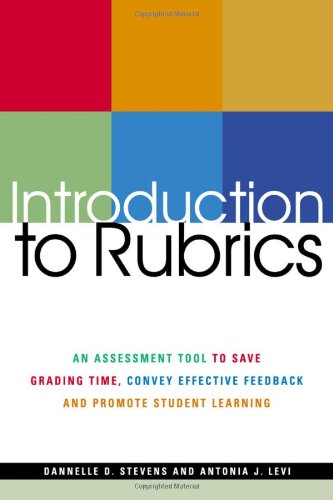
Today, a rubric retains its connection to authoritative rule and particularly to “redness.” In fact, professors like us who use rubrics often consider them the most effective grading devices since the invention of red ink.
At its most basic, a rubric is a scoring tool that lays out the specific expectations for an assignment. Rubrics divide an assignment into its component parts and provide a detailed description of what constitutes acceptable or unacceptable levels of performance for each of those parts. Rubrics can be used for grading a large variety of assignments and tasks: research papers, book critiques, discussion participation, laboratory reports, portfolios, group work, oral presentations, and more. …
Professors who regularly construct and use rubrics can create a rubric like the oral presentation rubric we used as an example in less than an hour, less if they are simply modifying an existing rubric designed for a similar assignment. For beginners, however, the first few rubrics may take more time than they save.
This time is not wasted, however. When we first began constructing and using rubrics, we quickly found that they not only cut down on grading time and provided fuller feedback to our students, but they affected our classroom preparation and instruction as well.
The first step in constructing or adapting any rubric is quite simply a time of reflection, of putting into words basic assumptions and beliefs about teaching, assessment, and scholarship. We put ourselves in the place of our students by recalling our own student days and focusing not only what we learned but how we learned it best—that is, what expectations were clear, what assignments were significant, and what feedback was helpful. That reflection translated into classroom practices as we became more adept at imparting not only our knowledge and expectations for each assignment, but what we hoped our students would accomplish through fulfilling the assignments we gave. Further down the road, we realized our students were not like us and out assignments should acknowledge different student learning styles. …
Moreover, although the first few rubrics may take considerable time to construct, they do save time in grading, right from the very beginning. When the sample rubric used in this chapter was used in a class of more than thirty students, for example, the time taken to grade the presentations was reduced to the actual class time in which the presentations were given, plus an extra hour or so devoted to adding a few individualized notes to each rubric. We simply circled whatever categories applied during or immediately after the student presented. Aside from saving time, this meant that the grades and comments were handed back to the students the very next class period, while the memory of the assignment was fresh in their minds. Timely feedback means more student learning.
Rubrics not only save time in the long run, but they are also a valuable pedagogical tools because they make us more aware of our individual teaching styles and methods, allow us to impart more clearly our intentions and expectations, and provide timely, informative feedback to our students.
Stevens, Dannelle D. and Levi, Antonia J. 2005. Introduction to Rubrics: An Assessment Tool to Save Grading Time, Convey Effective Feedback, and Promote Student Learning. Sterling, VA: Stylus Publications. pp. 3, 14-5. || Amazon || WorldCat
